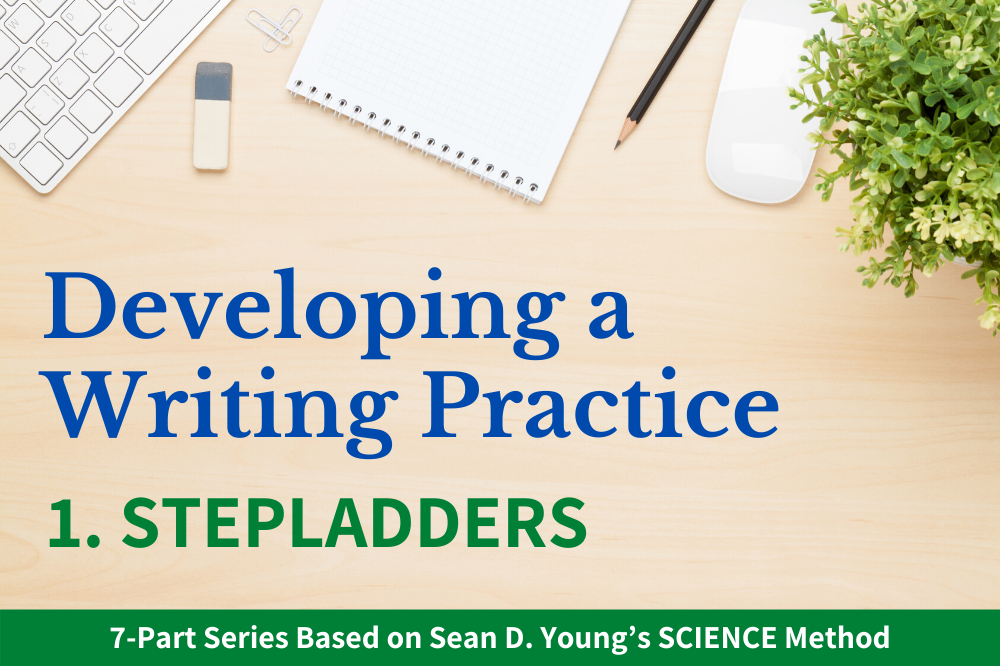
Today’s post is by regular contributor Susan DeFreitas (@manzanitafire), an award-winning author, editor, and book coach. She offers a first 50-page review on works in progress for novelists seeking direction on their next step toward publishing.
Recently, while browsing through ebooks available via my Scribd subscription, I came across Sean D. Young’s Stick with It: A Scientifically Proven Process for Changing Your Life—For Good.
The author is the director of the UCLA Center for Digital Behavior, and in this book, he shares the principles behind lasting behavioral change, backed by cutting-edge science. It occurred to me as I read it that these strategies could be especially useful for anyone struggling to establish a regular practice, and for those who’ve taken a break from writing as well.
Young’s acronym for those behaviors that lead to lasting change is SCIENCE, and the first of the strategies he outlines is the first S in that acronym: Stepladders.
Often we’re often told to focus on our big dream, our vision of the end result, as a motivating force for changing our behavior, but Young notes that numerous case studies actually indicate that we’re better served by focusing on the small steps that will get us there, and the short-term goals we can celebrate along the way.
“For example,” Young says, “you could either make a resolution to lose ten pounds before a wedding next month, or you could plan to go to the gym today. How exciting is it to make a resolution to go to the gym today? Not very.”
It’s a lot more fun, he notes, to dream of the end result. But focusing entirely on that big dream can actually cause you to become discouraged and quit because that dream is too big or too far in the future. The author notes that we’re generally more motivated by the process of achieving short-term goals, which increase our sense of self-efficacy—basically, our sense that change is attainable.
For writers, the big dream is often crystal clear. We want to finish that book (the one we’ve written just a few chapters of). We want to land an agent (for the novel we have yet to revise). We want to land a book deal and become a bestseller (though we know our manuscript is still far from polished).
Focusing on the big dream in such cases may not actually be all that helpful.
What can be helpful is focusing on the steps we can take now to get there, and, just as importantly, making sure those steps are small enough.
As a book coach, I’ve had many clients who struggle to find the time to write, though time itself isn’t usually the issue. (After all, we all tend to find time to scroll through our social media feeds and watch our favorite TV shows.) The issue is that these writers have set the bar so high for themselves, in terms of establishing a writing practice, that they inevitably disappoint themselves.
These are the clients who are just setting off on their journey as writers but have decided they will write for two hours three times a week, or for an hour every day, or for five hours every Sunday. More often than not, they fail to meet those goals, because they’re trying to get there too quickly.
If this sounds like you, what you probably need is a series of smaller, more achievable short-term goals—or, in Young’s parlance, a stepladder.
For a new writer, here’s an example of what the steps in such a stepladder might look like:
1. Monday: Prewrite
Taking the time to make notes about your story, your characters, and what your vision for it is—not just at the level of the finished story, but at the level of Chapter One, Scene One—can do a lot to prime the creative pump, making the actual writing much easier. (Plus, brainstorming tends to create less of a sense of pressure than actually sitting down to write).
2. Wednesday: Write (20–30 minutes)
Many people feel like if they can’t dedicate at least an hour to their writing practice, there’s no point in even trying. But when you have a clear idea of what you’d like to achieve at the level of the scene or chapter (see above), it can be a lot easier to make use of a short burst of time. (If it helps to keep you from overthinking it, set a timer for yourself as a motivator to keep writing forward.)
3. Friday: Revise and Write Forward (30–40 minutes)
Many writers find it easier to revise than to draft, and smoothing back over the last section you wrote can help to create a “runway” for writing more. As you revise, remember: You’re not trying to perfect this section of your story, you’re just trying to make it a little better.
For a writer who’s struggling to dig back into a complete draft of a manuscript and revise, the steps on their stepladder might look different, but within the scope of that big project, each step will still be small. For example:
1. Week One: Full read-through of manuscript with notes and brainstorm
If you find yourself struggling to revise, a good place to start is to print out the full manuscript and do a full read-though of the manuscript as it stands, making a note of the big-picture issues you’re seeing. (Don’t get caught up in the small stuff, though, unless you know the story itself is already sound.) After you’ve gotten a handle on these, brainstorm: What are some fixes you can see for these issues?
2. Week Two: Read through with highlighters and chapter notes
From here, you might go back through the MS and note where the issues you’re seeing show up in the manuscript. If it helps, use a different color of highlighter to track each issue across the manuscript—and as you go, create a list of chapter notes, addressing the things that need to change in each chapter to complete your overall revision.
3. Week Three: Revise Chapter 1
Revise Chapter 1, based on your chapter notes. Remember, you don’t have to “perfect” that chapter—you just need to check off the items in your notes for revising that chapter.
Different strategies will work for different writers, and for those at different points in their development: For some, a daily word count goal is a great motivator, while others find it helpful to focus on a time-based one. The key to applying the science around Stepladders is simply to make your first step small enough to feel achievable, and, just as importantly, to celebrate the achievement of those small, short-term goals—because it’s in the process of looking back and realizing that you’ve hit your short-term goals that you’ll build that sense of self-efficacy.
Too often in the rush to achieve our big dreams, we overlook how far we’ve already come. Take the time to celebrate the small steps and the little victories—in time, they really can add up to big ones.

Susan DeFreitas is the author of the novel Hot Season, which won a Gold IPPY Award, and the editor of Dispatches from Anarres: Tales in Tribute to Ursula K. Le Guin, a finalist for the Foreword INDIES. An independent editor and book coach, she specializes in helping writers from historically marginalized backgrounds, and those writing socially engaged fiction, break through into publishing.

[…] Susan DeFreitas: Developing a Writing Practice, Part 1: Stepladders […]
This is the most encouraging and enabling thing I’ve read in a long time. I’m one of those writers who focus on the end result, the big picture, which often turns into daydreaming rather than moving forward. I’ve published several books, but have been stuck on my current WIP for two years. I’m going to follow your advice and am confident it will help me finish. At any rate, I’ll stop beating myself up and get back to the joy of writing. Thank you.
This comment made my day! So glad I could be of service to you on this, Sandra. Wishing you all the best with your WIP.
[…] all a tad distracted by world events right now. Susan DeFrietas uses metaphorical stepladders to help her, Matthew Stibbe has 22 ways to help you focus on writing, William Fazer talks getting […]